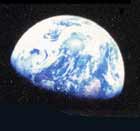|
Ice and snow
The winter ice cover on the Arctic Ocean is becoming smaller year
by year. It “has been declining at a rate that is twice as
fast as that predicted by 13 of the scientific community's best
large-scale models” (according to Matthew Sturm, “Arctic
plants feel the heat,” in Scientific American, May 2010)).
In March 2011 a two-decade NASA study found that the melting of
the Greenland and Antarctic ice sheets has accelerated: it is going
much faster than had been predicted only four years earlier.
White ice reflects
the sun's heat back into space whereas dark water absorbs it, thus
increasing the heating and the melting — an obvious feedback
loop.
A whole new island
has appeared out of the melting ice of Greenland. The Northwest
Passage through the Arctic north of Canada has opened, and shipping
lines are proposing new routes through it.
Canada's east coast
had in the winter of 2009-2010 the lowest ice formation on record.
This is disastrous for harp seals (which also suffer from an allowed
annual slaughter of their pups). Mother seals make an arduous spring
migration from Greenland in search of sea ice off the Canadian coast,
on which they give birth. Observers flying over in March 2010 saw
that, where in past years there had been solid ice with hundreds
of thousands of newborn seals, there was now open water with a few
dozen seals clinging to fragments of melting ice. In these conditions,
the mothers are forced to abort their offspring in the water.
Polar bears subsist
by hunting seals from the floating sea ice in the winter, and must
get time to store up enough body fat to survive the summer on land
without food. But now the ice forms later in the autumn, covers
smaller areas, and melts sooner in the spring.
There are 19 subspecies
of polar bears; the best studied is that in the western Hudson Bay,
and researchers from the University of Alberta published a thorough
study of it in 2010, aided by computer models of the bears' needs
and metabolism. The bears now have to survive three more starving
weeks on land each year than in the 1980s, they are smaller and
weaker (weight declined by an average of 60 pounds, body length
by 10 percent), so they die more readily and have fewer surviving
pups; their numbers shrank from 1,200 to 900, they are likely to
be lost within thirty years or as few as ten if the ice disappears
even faster.
The seas off Antarctica have been warming faster than the global
average. This is causing the ice shelves, which project off the
continent onto the water, to retreat. In 2002 a huge area of the
Larsen Ice Shelf at the edge of Antarctica collapsed. In April 2009
the Wordie Ice Shelf disappeared altogether.
In these southern
waters, the food chain depends on the small crustaceans called krill.
But they depend on small plants that grow on te underside of the
disappearing ice shelves. Gentoo penguins, which live in warmer
seas than other species, have been moving southward.
In the Himalayan mountains, the snow cover is rapidly dwindling.
Photographs of mountain ranges taken in 1968 and 2007 show glaciers
shrunken and the snow line hundreds of feet higher. The glaciers
of this highest region of the world are the sources of the great
rivers (Yellow, Yangtze, Red, Mekong, Salween, Irrawaddy, Brahmaputra,
Indus) that supply water to the Indian subcontinent, southeast Asia,
and China — an enormous fraction of the world's population.
In Ladakh (“Little
Tibet,” the northernmost part of India) most farmers depend
on runoff water from glaciers. Average temperatures have risen by
1C in winter and 5C in summer from 1973 to 2008, less snow falls
and it disappears more quickly, so glaciers and irrigation water
are disappearing. A local engineer has been meeting a little of
the farmers' desperation by making “artificial glaciers”
(in winter the water in some pipes is allowed to keep running, though
not needed, to stop it from freezing; instead he lets it out through
holes to freeze on north-facing hillsides, thus saving it for the
summer).
Melting ice on the
upper part of Mount Everest has in recent years revealed oxygen
tanks and other trash jettisoned by climbers. (In the spring of
2010 a Nepali clean-up expedition brought down seven tons of this
trash.)
In the great Andean mountain region of South America, temperatures
have risen and scientists predict that they will rise faster: it
is estimated that there will be a further rise of nearly 5°C (9°F)
by 2100, greater than over the past 10,000 years, “with unforeseen
consequences for agriculture and power generation.”
Bolivia's Telata
glacier has shrunk by 2/5 since 1820. Southern Chile is a maze of
fiords, forests, and glaciers, still largely inaccessible and pristine.
It is being polluted by thousands of salmon farms, which after ruining
one body of water move south to the next; and foreign companies
with concessions given to them by the former Pinochet dictatorship
are poised to build unnecessary and destructive dams; but (according
to a National Geographic article, Feb. 2010) “The gravest
danger to the Chilean fiords is, of course, climate change, which
threatens to alter the rivers that depend on these glaciers and
upset the balance of salt and fresh water in the inner fiords.”
Of 48 glaciers, one is advancing, one is stable, and 46 are retreating.
Mount Kilimanjaro, Africa's highest mountain, near the equator,
once had a summit covered by ice up to 100 meters deep. It has lost
75% of this ice, by mass, since 1912. Photographs taken only 14
years apart (1984 and 1998) show the icecap greatly shrunken.
return
|

